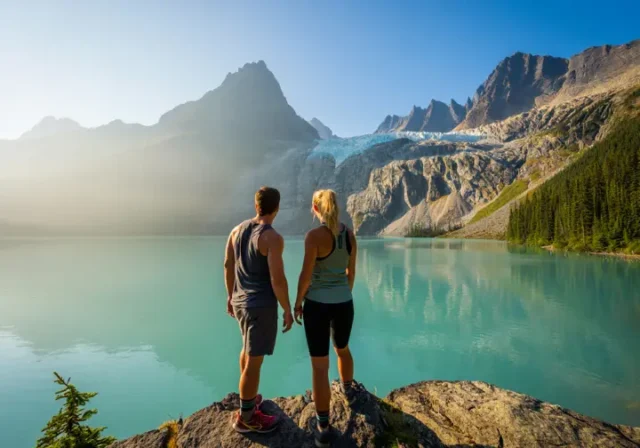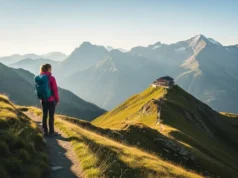In this article
Joffre Lakes Provincial Park, with its three stunningly turquoise lakes and the majestic Matier Glacier, is one of British Columbia, Canada’s most iconic hikes, as Joffre Lakes is one of BC’s most beautiful hikes. This guide provides the essential, skills-focused information you need to plan your trek to joffre lake british columbia, from securing a pass to navigating the trail safely and ethically.
This journey to the three lakes, a trio of stunning alpine lakes, is more than just a walk; it’s an education in modern park stewardship. You will learn about the mandatory pass system born from necessity, the park’s deep cultural significance to the Líl̓wat Nation and N’Quatqua, and the practical skills required for both summer hiking and advanced winter trekking in this part of British Columbia. Prepare for a comprehensive look at hiking, camping, safety, and responsible recreation.
Understanding Joffre Lakes: The Essential Facts
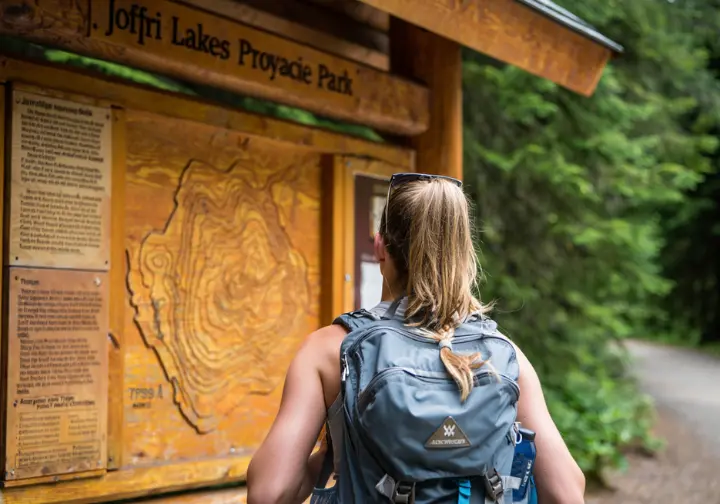
Before diving into logistics, it’s crucial to understand the context of the park. A visit here is not just about the stunning views; it’s about appreciating the land’s deep history and being prepared for its physical demands. This section covers its cultural significance, its Indigenous heritage, and provides a quick, data-driven overview of the hike’s key statistics.
The Land and Its People: Acknowledging Pipi7íyekw
Before it was a world-famous park, this land held deep meaning. Joffre Lakes Provincial Park lies within the Squamish-Lillooet Regional District, British Columbia, on the traditional, ancestral, and unceded territories of the Líl̓wat Nation and N’Quatqua. Its traditional St̓at̓imcets name is Pipi7íyekw, meaning “a camping place where storage houses were,” a name that reflects a history of use and stewardship long before it became a recreational hotspot.
This heritage is now formally recognized, as the park is collaboratively managed through a partnership between BC Parks, the Líl̓wat Nation, and N’Quatqua. This modern approach to stewardship has a dual purpose: to protect the park’s sensitive alpine ecosystems from overuse and to support the Nations’ continued spiritual and cultural connection to the land.
A key outcome of this collaboration is the implementation of temporary seasonal closures. For instance, the planned closure in June 2025 is not just for trail maintenance. It is a deliberate action to allow the land to recover and, equally important, to provide private time for the Líl̓wat and N’Quatqua to reconnect with their territory for cultural practices, underscoring a modern approach to park stewardship that balances recreation with cultural respect.
Joffre Lakes at a Glance (Fact Sheet)
Every successful hike begins with understanding the fundamental data of the trail. This fact sheet consolidates the critical information you need to set clear and safe expectations for your trip to this incredible provincial park.
| Metric | Details |
|---|---|
| Official Name | Pipi7íyekw/Joffre Lakes Provincial Park |
| Location | Off Duffey Lake Road (Highway 99), between Duffey Lake Provincial Park and Pemberton |
| Round-Trip Distance | Approximately 10 km (6.2 mi) |
| Elevation Gain | 370–464 m (1,213–1,522 ft) |
| Average Hiking Time | 3–5 hours (excluding breaks) |
| Difficulty | Intermediate (can be strenuous for beginners) |
| Key Features | Three glacier-fed lakes (Lower, Middle & Upper); Matier Glacier; Holloway Falls |
| Permits Required | Yes. Day-Use Pass or Backcountry Camping Permit is mandatory. |
| Dogs Allowed | No. Dogs and other domestic pets are strictly prohibited. |
| Cell Service | None/Unreliable. Download or print all passes and maps. |
While the trail is officially rated as “Intermediate,” this deserves context. For a seasoned hiker, the consistent uphill push may feel moderate. However, for a beginner not accustomed to rocky terrain and sustained elevation gain, the main climb can feel very strenuous. This is why having a good checklist of essentials for a day hike is so critical.
The most important takeaways from this data are the non-negotiable park rules that ensure safety and conservation. A permit is absolutely required for access. Dogs are strictly prohibited to protect the fragile environment and wildlife. Finally, the lack of reliable cell service means you are your own first line of defense; you must arrive with your pass, maps, and all necessary information already saved offline or printed. A trip to Joffre Lakes Provincial Park is a commitment to self-reliance.
The Essential First Step: Securing Your Park Access
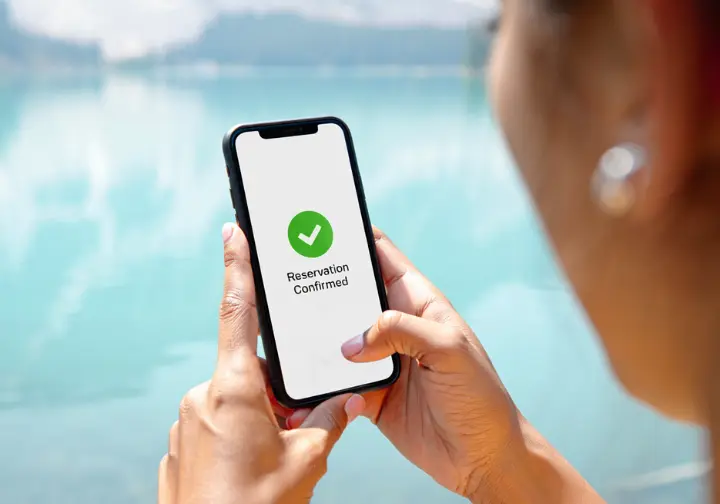
A successful and legal trip to Joffre Lakes hinges entirely on navigating its mandatory reservation system. The days of spontaneous visits are over, a direct result of the park’s immense popularity and the critical need to protect its fragile environment. This section provides a detailed, practical guide to securing both day-use and camping permits to access Joffre Lakes.
The Joffre Lakes Day-Use Pass: Your Ticket to the Trail
The day-use pass system exists for a crucial reason: to combat the negative impacts of extreme visitor numbers. Unmanaged crowds in the past led to severe trail degradation, unsafe Joffre Lakes parking conditions along the highway, and an overcrowded, diminished experience for everyone. Understanding that the pass system is a conservation tool can help ease the frustration of the highly competitive booking process.
To get your pass, you must go to the official BCParks website. Passes become available online at 7:00 AM Pacific Time, exactly two days in advance of your planned visit, and they are free of charge. A pass is required for each individual visitor, so ensure you book one for everyone in your group. Remember to have a printed or saved digital copy of your pass before you arrive, as you will have no cell service to access it at the park entrance.
[PRO-TIP] The high demand for Joffre Lakes passes has created an intensely competitive booking environment, often called “the 7 AM scramble.” Passes for weekends can be fully booked within seconds. To increase your chances, create a BC Parks account in advance to expedite checkout. Be on the booking page and ready to refresh at precisely 7:00 AM PT. If you fail, don’t give up—cancelled passes are returned to the inventory immediately and can appear at any time, so check back frequently.
Backcountry Camping at Upper Joffre Lake
For a more immersive experience, you can camp overnight, but it is strictly limited to the official backcountry campground at Upper Joffre Lake, the top lake on the trail. The campground contains 26 designated gravel tent pads, a pit toilet, and communal metal food caches, which are essential for safe food storage near the snout of the glacier in an area inhabited by both black and grizzly bears.
Reservations for camping are entirely separate from the day-use pass system and must be made through the BC Parks camping reservation website. The booking window is highly specific to the season, so you must check the official site for the current year’s dates. Camping fees are charged on a per-person, per-night basis. With a valid camping permit, you do not need a separate day-use pass for the duration of your stay.
Adhering to backcountry ethics is not optional. Campfires are strictly prohibited year-round; all cooking must be done on a portable stove. You must follow the “Pack It In, Pack It Out” rule, meaning all garbage, including food scraps, leaves with you. Lastly, BC Parks no longer supplies toilet paper at backcountry outhouses, so you must bring your own water and toilet paper. Also, be aware that the recreational use of drones in provincial parks is generally restricted to protect wildlife and the visitor experience. A good packing list for an overnight trip will ensure you don’t forget these crucial items.
The Journey to the Glaciers: A Trail Guide for All Seasons
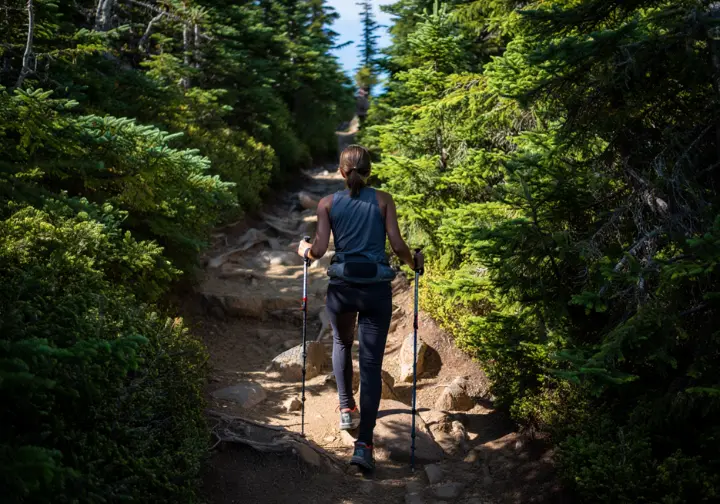
The hike through Joffre Lakes Provincial Park is a journey of escalating beauty, with each of the three lakes revealing a more dramatic and vibrant scene than the last. However, the experience of the trail transforms dramatically with the seasons, shifting from a popular summer trek into a serious winter mountaineering objective that demands advanced skills and respect.
Summer Hiking: A Step-by-Step Guide to the Three Lakes
The classic summer hike in Joffre Lakes Park begins with an immediate and easy reward. A short, mostly flat 500-metre walk from the parking lot leads directly to the shores of the first lake, Lower Joffre Lake, offering a picture-perfect scene of the turquoise water with the Matier Glacier visible in the distance. This first stunning viewpoint sets the stage for the climb to come.
The segment from the first lake to the second lake, Middle Joffre Lake, is the heart of the challenge, containing the majority of the hike’s 370-plus metres of elevation gain. The trail becomes consistently rocky and root-filled, demanding sturdy footwear and careful footing. While recent trail upgrades have improved a notoriously difficult boulder field, the climb remains steep and unrelenting. The reward for this effort is the piercing blue lake known as Middle Joffre.
From Middle Lake, the final leg to the third lake, Upper Joffre Lake, is shorter and less demanding. The trail crosses a bridge and passes the beautiful and scenic waterfall known as Holloway Falls, which is fed by streams from the upper lake. The journey culminates as the trail opens up to the grand expanse of Upper Joffre, where the Matier Glacier and its surrounding blue glaciers dominate the skyline. Any routes beyond this extraordinary lake are serious undertakings that should not be attempted by casual day hikers, as they are unmaintained and challenging scrambles. When hiking, remember to Leave rocks, plants, and other natural objects as you find them.
Winter at Joffre Lakes: A Critical Safety Advisory
Visiting Joffre Lakes in winter is to experience an entirely different destination. The famous turquoise water is hidden beneath a thick layer of ice and snow, and the landscape is transformed into a serene, stark world of white. The trail, though often tracked out, can be treacherous, with packed snow becoming extremely slippery and icy.
CRITICAL SAFETY ADVISORY
The Joffre Lakes trail travels directly through and below serious avalanche terrain. It cannot be overstated: anyone venturing past the Lower Lake viewpoint in winter or spring should have formal avalanche safety training (AST 1 minimum). All members of a winter party must carry, and know how to use, a full set of avalanche safety gear: a digital transceiver, a probe, and a metal shovel. The area around the summer campground at Upper Lake is particularly hazardous, as it sits in a frequent avalanche runout zone.
Specialized gear is mandatory, not optional. The icy conditions make essential traction devices essential, such as snowshoes or microspikes. Winter camping is an activity reserved strictly for experienced and fully equipped winter adventurers who understand cold-weather survival. This commitment to safety and preparedness is a core component of The 7 Principles of Leave No Trace.
Hiking with Respect: A Guide to Responsible Recreation
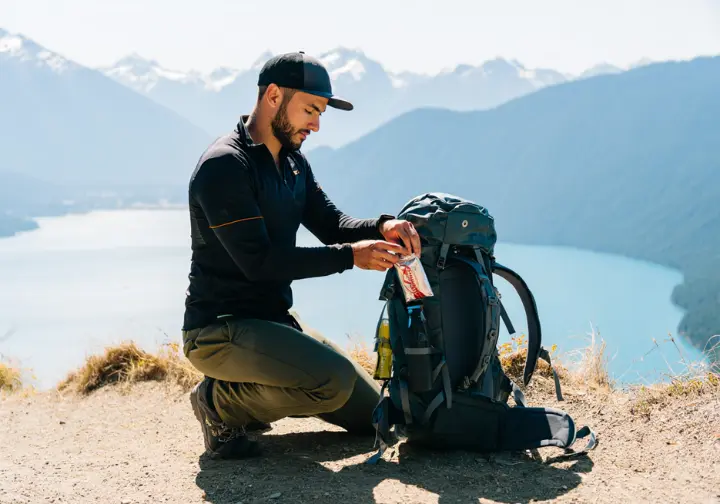
Visiting Joffre Lakes comes with a profound responsibility to protect its fragile alpine environment and respect its deep cultural significance. The park’s very management plan is a response to it being “loved to death,” and every visitor plays a role in its preservation. By embracing the principles of Leave No Trace, you can move from being a passive consumer of scenery to an active steward of the land.
Embracing Leave No Trace in a Fragile Environment
BC Parks expects all visitors to Pipi7íyekw/Joffre Lakes to strictly adhere to Leave No Trace ethics. This framework provides a simple yet powerful way to minimize your impact. A core principle is to Travel and Camp on Durable Surfaces. This means you must always stay on the designated trail, even when it is wet or muddy. Walking around muddy patches widens the trail, tramples delicate vegetation, and causes permanent erosion. Similarly, backcountry camping is only permitted on the designated gravel pads.
Another non-negotiable rule is to Dispose of Waste Properly. This means packing out every single thing you bring in, including all food scraps like apple cores and banana peels, which can take years to decompose in the cool air of these challenging alpine lakes. If you must use the bathroom away from a toilet, dig a “cathole” 15-20 cm deep at least 70 metres from any water source, like the creek or the lakes, and bury your waste, packing out your toilet paper.
The remaining principles are just as important. Minimize Campfire Impacts is simple at Joffre: fires are prohibited year-round. Respect Wildlife means observing animals from a safe distance and never feeding them, as this can endanger both the animal and other humans by making them habituated and aggressive. Your actions directly contribute to the park’s future.
Conclusion: Your Adventure, Your Responsibility
Joffre Lakes offers an incredibly rewarding hiking experience, a chance to witness some of the most spectacular glacial scenery in British Columbia. This reward, however, is accessible only through careful and diligent planning. Securing a pass is the mandatory first step, and the trail’s difficulty, while moderate, should not be underestimated.
It is critical to remember the safety distinction between a beautiful summer hike and a serious winter objective. A winter visit demands specialized gear, avalanche safety training, and a profound respect for the power of the mountains.
Ultimately, visiting Pipi7íyekw is a privilege. That privilege comes with the responsibility to be an active steward of the land. By preparing thoroughly, hiking safely, and practicing Leave No Trace ethics with every step, you ensure that this special place can continue to recover and inspire for generations to come.
We encourage you to share your own responsible hiking practices or ask any further planning questions in the comments section below.
Frequently Asked Questions about Joffre Lakes
How hard is the Joffre Lakes hike for a beginner?
The hike is considered challenging for beginners. This is mainly due to the very steep and sustained climb on rocky terrain between Lower and Middle Lake. Beginners with a good level of physical fitness can certainly complete it but should be prepared to take plenty of breaks and allow for extra time.
Can you swim in the lakes?
Yes, swimming is technically permitted in the freshwater lakes. However, the water is glacially fed and remains exceptionally cold (near freezing) even on the hottest summer days. The danger of cold shock and hypothermia is very real. If you choose to swim, it is at your own risk, and you should stay very close to shore.
Are dogs or other pets allowed at Joffre Lakes?
No. To protect the park’s sensitive ecosystem and wildlife, dogs and all other domestic pets are strictly prohibited in the entire park. This rule applies to all areas, including inside vehicles in the parking lot, and is enforced to prevent disturbance to local fauna and flora.
What is the best time of year to see the turquoise lakes?
The lakes’ famous turquoise color is most vibrant from late June through September. This is the period when the pristine turquoise waters are fully melted and illuminated, allowing sunlight to reflect off the suspended glacier-ground rock particles that cause the iconic color.
We are a participant in the Amazon Services LLC Associates Program, an affiliate advertising program designed to provide a means for sites to earn advertising fees by advertising and linking to Amazon.com. As an Amazon Associate I earn from qualifying purchases. We also participate in other affiliate programs. The information provided on this website is provided for entertainment purposes only. We make no representations or warranties of any kind, expressed or implied, about the completeness, accuracy, adequacy, legality, usefulness, reliability, suitability, or availability of the information, or about anything else. Any reliance you place on the information is therefore strictly at your own risk. Additional terms are found in the terms of service.



